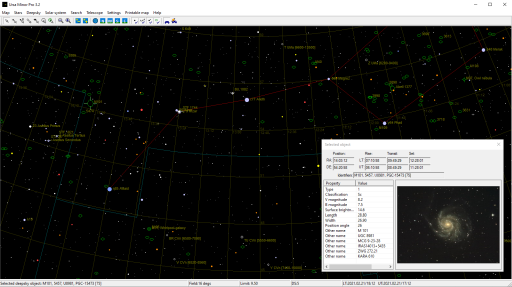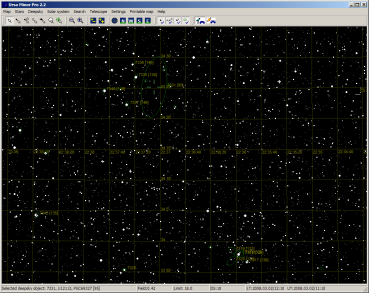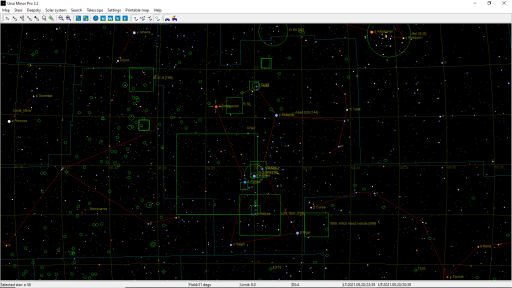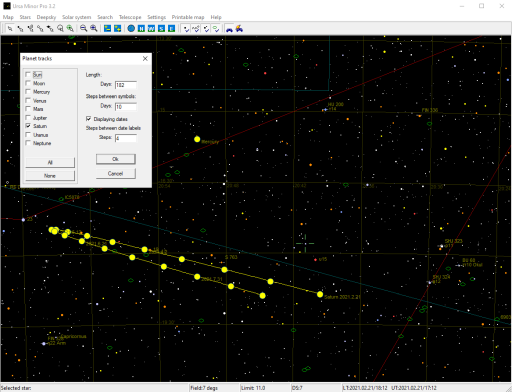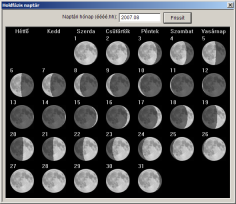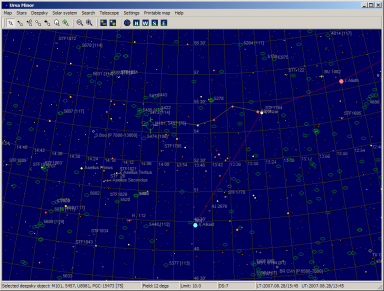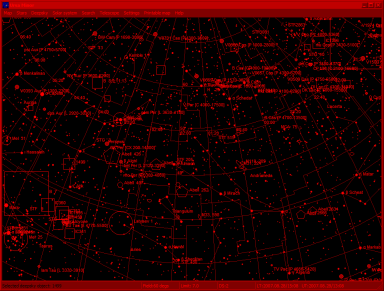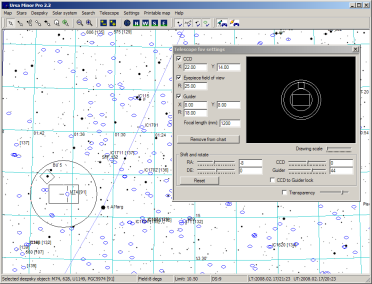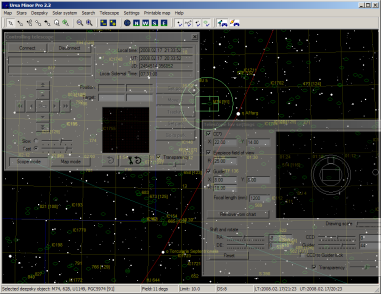Ursa Minor Pro
Planetarium and telescope controller program for advanced hobby-astronomers
Introduction
The program can display the night sky as can be viewed from the Earth from any position and any time. The map can be easily positioned and zoomed showing fields of view ranging from the entire visible sky down to a detailed "finder chart" for a faint distant galaxy. You can use flexible search functions to locate any kind of celestial objects such as stars, variable or double stars, deepsky objects or planets of the Solar system. The map also can be printed for observations, even in mirrored or rotated mode for several types of telescopes.
Main features
- Controlling telescopes
- Ursa Minor Pro can control several types of telescope mounts.
- Displaying star charts
-
Colorful, highly detailed and customizable map of any part of the sky can be displayed. The map can be easily
positioned and zoomed. The program can work with several star catalogs. The most detailed amongs them is the USNO-A2
catalog, which contains data about 500 million stars up to 18-20 magnitudes. This catalog, as most of the
astronomical databases, can be freely distributed and downloaded from the Internet for educational and research
purposes. However it's free, downloading such a huge volume of data (more than 6 gigabytes) can be difficult. When
you purchase Ursa Minor Pro, you will receive a free copy of this catalog.
On the following screenshot you can see Ursa Minor showing a star map with magnitude limit of 18. The displayed region is the area of Stephan's quintett and NGC 7331 galaxy in the Pegasus constellation. The field is less than one square degrees. By modifying field of view (zooming in and out) the program control magnitude limit automatically. By controlling magnitude limit the switching between star catalogs will be also performed automatically. This operation can be disabled when you prefer manual settings. - Solar system
- The program displays position of the Sun, Moon and planets regaring to given time and date, or can draw orbital tracks for given time period. The positions are calculated with a very accurate algorythm. Display or print a monthly calendar (for any month) with the phase of the Moon, great for planning observing sessions! Large amount of minor planets and comets also can be displayed. These positions are calculated by an up-to date catalog, which can be upgraded periodically from the homepage of the Minor Planet Center.
- Deepsky objects
- Displaying deepsky objects by different symbols for each type of object. Galaxies and nebulaes are symbolized reflecting their apparent size and orientation. Flexible filtering options are available to control visibility of deepsky objects.The program works with a rich deepsky catalog containing more than 78000 objects. Filtering deepsky objects can also be done by an automatic or manual way. Filtering can be done in object type basis, for example enabling a bit more galaxies than other objects or completelly disable any kind of objects.
- Star hopping
- This function will be interesting especially for beginners. This means a visual guide to help locate a popular deepsky object by showing a virtual path, jumping star by star leading to the selected deepsky object. The program advises this route by its internal database containing real starhopping tips collected by amateur astronomers. Star hopping was never easier! Print a hard copy of map, and use it in the field to help identify objects.
- Observing tips
- Plan observing sessions with Observing tip finder that instantly gives you a list with popular sights. This list will be generated upon given date and time, and by choosen telescope size.
- Searching for various types of objects
-
Ursa Minor Pro has a powerful Find feature so you can easily locate any object (more than 2 million of them!) from
the program's astronomical databases. You can locate stars by many identifiers:
- Common name
- Bayer and Flamsteed sign
- SAO, PPM, Hipparcos, Tycho catalog identifiers
- Durchmusterung designation (Bonner, Southern or Cordoba)
- Variable star identifers
- Name of double stars, as listed in WDS catalogue (Washington Double Star Catalogue)
- Messier catalog number
- NGC or IC number
- UGC, PGC identifier
- Provisional id
- Number
- Common name
- Projections and mirroring
- Several projections and optional mirroring mode. The program easily can demonstrate features of different projection modes such as orthographic, stereographic or gnomonic.
- Activate night vision mode for in-the-field use
- Change the computer screen to red to preserve dark adaptation. Great when using Ursa Minor at your telescope.
- Controlling telescopes
- One of the most popular functions of the program. It can control a large variation of GOTO telescope mounts. All of them are supported directly, so you don`t have to obtain other software components, such as Ascom driver. Telescope can be directed manually by arrow buttons or more conveniently with a gamepad. Positioning to any object is as easy as a simple mouse click. If the seeked object is not exactly at the center of the field of view, the program can drive the telescope slowly on a spiral line, so the object will appear soon. For more information please choose Telescope controlling page.
- Make auto guiding easier
-
The program can interoperate with an autoguider program by monitoring its guiding commands. Ursa Minor receives these
signals and sends them to the mount on one cable with goto, manual movement and DSLR camera controlling signals. The
result is fewer cables and fewer troubles. On the image you can see how monitors Ursa Minor the signals of the
autoguider program.

- Controlling DSLR camera
-
Ursa Minor can control the exposition of a Canon EOS 350D or compatible DSLR camera. You can make multiple frames
easy as shown in the following image.
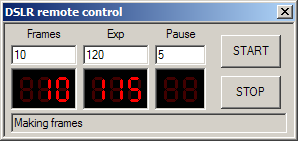
- Eyepiece or CCD field of view
- This feature is useful for preparation for an observing session. Eyepiece field of view symbol can be displayed, and you can see which part of the sky will be visible through your telescope. Not only eyepiece fov, rather CCD frames and off-axis guider frame can be displayed. For longer exposure astrophotography it is essential to use guiding. Off-axis guider is an excellent way, because it uses main tlescope, and fainter star can be choosen for guiding. However, adjusting off-axis guider, and centering guider star in autoguider camera is a bit difficult. Ursa Minor's "Field of view adjustment" feature can help you. By this way you can graphically shift or rotate CCD and guider prism symbols on map to seeking a proper guiding star. When you have finished, proper rotation angles and shifting values are displayed in the dialog box, and you can use these values for rotating guider on your telescope.
- Printable sky maps in PDF format
- High quality printable maps in PDF format can be created easily with Ursa Minor.
- Transparent dialog boxes
- During observations, you may need to keep open the telescope controller and CCD frame settings dialog boxes. These windows are relatively large, therefore they overlap large area of the displayed sky map. Is such situation the Transprency feature can be useful. The level of transparency can be adjusted and even switched off.
Uprgading minor planet and comet data
Up to date minor planet and comet datafiles can be downloaded from Minor Planet Center. The files are updated daily.
- Soft00Cmt.txt
- Viewable comets
http://cfa-www.harvard.edu/iau/Ephemerides/Comets/Soft00Cmt.txt - Soft00CritList.txt
- Critically listed minor planets
http://cfa-www.harvard.edu/iau/Ephemerides/CritList/Soft00CritList.txt - Soft00Distant.txt
- Bright distant minor planets
http://cfa-www.harvard.edu/iau/Ephemerides/Distant/Soft00Distant.txt - Soft00Unusual.txt
- Minor planets with unusual orbit
http://cfa-www.harvard.edu/iau/Ephemerides/Unusual/Soft00Unusual.txt - Soft00Bright.txt
- Bright minor planets
http://www.minorplanetcenter.net/iau/Ephemerides/Bright/2011/Soft00Bright.txtThis file is related for one particular year. Please consider the year number in the URL.



